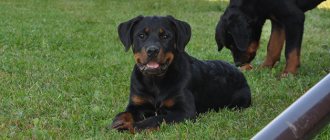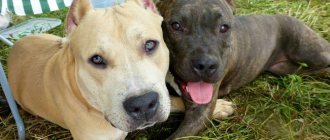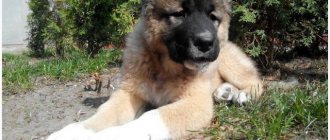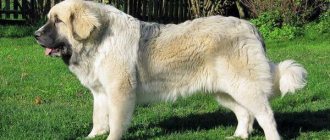Cropping a shepherd's ears is a procedure established by certain standards, which for certain species has a historical justification. Long drooping ears made the dogs vulnerable during fights with wild predators. The operation to shorten the ear is not performed on all shepherd breeds.
For dogs that do not herd herds or encounter predators in nature, this operation is optional and is purely cosmetic. Some species, such as the German Shepherd, for example, simply need to position their ears correctly so that they do not droop.
What dog breeds have their ears cropped?
Currently, the following dog breeds most often have their ears cropped:
- Doberman;
- pit bull terrier;
- Cane Corso;
- miniature pinscher;
- boxer;
- Great Dane;
- schnauzer;
- Staffordshire Terrier;
- Central asian shepherd dog;
- Caucasian Shepherd Dog.
Important: each breed has its own ear cut according to its own pattern. The final shape of the ears should correspond to the appearance of the dog.
Shepherd dog ear cropping – reasons and indications
Ear cropping of a shepherd dog is performed for several reasons. Some of them are due to necessity or medical indications, others are a tribute to fashion, following canine standards.
Medical indications:
- Injuries to the ear.
- Tumors.
- Ulcerative lesions.
- Necrosis of ear tissue due to frostbite.
- Burns.
- Prevention of otitis.
- Reducing the likelihood of developing auricular lymphatic extravasation.
Aesthetic reasons:
- Giving a scary look.
- Following the accepted breed standard.
- In the distant past, the ears of dogs that attacked humans were cropped. Thus, a kind of mark was placed on the animal.
Functional reasons:
- Protect your ears from predators. Painful lacerations on the ears disoriented the animal and caused blood loss, infection, and infection.
- Possibility of ear injuries during teenage games of puppies, attempts to divide the territory in adolescence.
- Protection against ear injuries for dogs who have taken part in dog fighting, hunting big game and predators.
- Protection against parasite bites: ticks, mosquitoes.
- Makes it easier to care for the Caucasian Shepherd's ears.
Important: in most European countries today cupping is prohibited unless it is a necessary part of treatment. The exception is dogs in service. In Russia, such a law has not been adopted.
Central Asian Shepherd (Alabai)
Is it necessary to dock the tail?
Based on aesthetic considerations, then more likely yes than no, especially when plans include ear cropping. In the early stages, docking the Caucasian Shepherd's tail will be less painful than at an older age. In this case, the animal faces a serious operation using general anesthesia.
You can painlessly and quickly tail dock from the 3rd to the 10th day of a puppy’s life. There are enough ways to do this, but any of them must be applied by a specialist.
The following video is not recommended for viewing by children and people with weak mental health.
The ears are an organ that has a large number of nerve endings, and when injured, there is an increased risk of bleeding.
Contraindications to ear trimming
Like any surgical procedure, ear cropping surgery has a number of medical contraindications.
So, they don’t do ear amputation:
- sick dogs;
- weakened pets;
- animals of inappropriate age;
- dogs in the recovery period after surgery and severe long-term illnesses;
- puppies with developmental disabilities.
The likelihood of developing complications after surgery depends on the professionalism of the doctor and the reputation of the clinic where the amputation was performed. This operation is expensive, it is not worth saving on it.
Advantages and disadvantages
The advantages include a well-groomed appearance and a familiar appearance.
There are significantly more downsides to it. These dogs are among the breeds that may experience behavioral disturbances after experiencing pain. Ears also play an important role in the animal’s communication with both humans and its fellow animals. For example, if a dog raises its ears, it means it senses danger, and if it tightens its ears, it means it obeys. Removal deprives her of the opportunity to express her emotions and fully communicate.
The most painless option, which virtually eliminates subsequent complications, discomfort and bleeding, is ear and tail docking
tiny creatures directly during childbirth. For breeds with complex ear shapes, surgery is usually performed somewhat later, at up to 45 days of age.
There are also numerous cases of late surgical intervention, but, according to reviews from many dog owners, it is better not to do this. According to the owners, the pain in pets is stronger, the general condition after the operation is much worse, heavy bleeding is possible, as well as more serious complications, which will be discussed below.
The timing of the operation, its possibility and necessity, of course, largely depend on the characteristics of the breed and on the views of the owners on this issue.
For example, ear cropping from a staff
Recently, it has been carried out only at the request of the owner, and specimens of this breed in their original form, gifted by nature, are increasingly appearing in domestic rings.
Surgery is usually performed on these dogs at around 7 weeks of age. It often happens that puppies are still with the breeder at such a time. But if the owner acquires a sufficiently old pet with undocked ears, then the procedure is still possible provided it is carried out in a good clinic under general anesthesia.
Performing the operation on mature dogs is acceptable, but in this case, the cost of ear cropping
.
The price
of the service, it should be noted, directly depends on various factors: the breed of the dog, the age and size of the animal, and also, of course, on the price list of each specific clinic. It can be 2000 rubles or higher.
Owners should also remember that the described procedure is carried out on an empty stomach. And for its successful implementation, it is necessary that the pet refrain from eating food for at least 10 hours.
Special pattern for cropping ears in dogs
Before circumcision, you should carefully monitor your pet’s health for several days, always recording any possible deviations from the norm. If in doubt, you should consult a veterinarian. The pet's ears should be thoroughly cleaned before the procedure.
Types of cupping
Depending on the breed, ear trimming is performed in different ways.
- Complete trimming (removal) of the ear - Central Asian and Caucasian Shepherd Dogs.
- Trimming the ear by two thirds - Canary Dogs, Staffordshire Terriers, Cane Corsos.
- Removal of the third part of the ear – miniature pinschers, Dobermans.
- Removal along the entire length - mastiffs.
Important: For shepherd breeds, the ear is completely cut off during docking.
All about ear cropping for Caucasian Shepherd dogs
Let's consider the main features of ear cropping (trimming) of a Caucasian Shepherd dog: indications for cropping, age of the operation, features of the procedure.
At what age is ear cropping performed?
Newborn Caucasian Shepherd puppies undergo complete ear amputation in the first week of life. The optimal age is 1.5 - 3 days. Upon reaching three days of age, the ears of a little Caucasian begin to actively grow and quickly thicken. In exceptional cases, cupping of the concha without anesthesia and sutures is allowed up to seven days of age. If you miss this period, the relief will be more painful, with severe blood loss, and serious postoperative complications may develop.
A Caucasian Shepherd with undocked ears can be operated on by a new owner upon reaching 6-7 months of age. But in this case, you will have to do the procedure under general anesthesia in a veterinary clinic. Late cupping is dangerous due to a long recovery period, severe stress for the pet, large blood loss, and a high level of injury. It is best not to delay this process and cut off the ears in infancy.
How to crop the ears of Caucasian Shepherds
Representatives of this breed undergo a complete trimming of the upper part of the ear. If docking is carried out within the recommended time frame (1.5-3 days), then you can do without visiting a veterinary clinic and do the trimming at home. For Caucasians, there are no uniform patterns for trimming; the breeder or veterinarian conducting the procedure is guided by the length and thickness of the puppy’s ears.
When performing the operation at a later date (6-7 months), you will have to prepare your pet for this serious painful manipulation. The day before the scheduled operation, the dog is not fed and is kept on a starvation diet. The operation is performed under local anesthesia and general anesthesia, so you will have to take the animal to the clinic.
Before the procedure, the ears are shaved to remove hair. Patterns are placed on the ears. The surgical area is carefully treated with antiseptics, after which an incision is made into the cartilage of the auricle from the edge to the central part. After the shepherd dogs' ears are cropped, the incision is processed and stitches are applied. After the wounds have completely healed, they are removed, usually within 8-12 days.
Caucasian Shepherd Dog
What is postoperative care?
A successful operation is only half the battle. Further healing of the injured area will depend on proper post-operative care. Responsibility for this falls on the dog's owner, without whose help the pet cannot cope.
What to do after surgery:
- Put a plastic “Elizabethan collar” on the animal so that the dog does not have the opportunity to scratch the wound.
- Give your dog pain medications as prescribed by your veterinarian to reduce and relieve pain.
- On the first day after the operation, which was performed under general anesthesia, reduce food portions and give food little by little. This will help cope with a possible gag reflex.
- Treat wounds and stitches daily with hydrogen peroxide, brilliant green, calendula tincture or streptocide in powder form. The optimal treatment must be prescribed by a veterinarian. This should be done carefully with cotton pads or cotton swabs.
Important: the owner must carefully monitor the dog’s condition in the postoperative period in order to notice possible deterioration in time and contact a veterinarian.
Possible complications after surgery
When the procedure is performed correctly, complications rarely occur. But, if the operation was carried out by non-professionals, in insufficiently sterile conditions, or the owner did not follow all the recommendations of specialists when caring for the pet after the manipulation, complications may develop.
- Severe bleeding after amputation in adulthood.
- Thickenings and scars form at the site of removal.
- An inflammatory process develops in wounds.
You can avoid these troubles by choosing a professional veterinarian or a good clinic. After the operation, it is necessary to constantly examine the dog and remove the stitches in a timely manner.
Care
The most difficult and dangerous period comes after the surgeon’s work is completed, because now it is necessary to properly heal the wounds and help the animal recover from anesthesia.
Mandatory conditions for a full recovery after surgery are:
- Close observation of the animal on the first day after anesthesia. It is at this time that the negative effects of the drug may appear. Particular attention should be paid to water and food. If the first one must be available in any quantity at all times, then food is given in small portions at fairly large intervals, carefully monitoring the reaction to them, because the dog may vomit.
- Mandatory wearing of a special collar , which is a plastic bell that does not interfere with eating and moving, but does not allow you to reach the seams with your paw in order to comb the wounds and introduce infections into them.
- Mandatory daily treatment of the wound edges with hydrogen peroxide and brilliant green. In this case, it is necessary to ensure the sterility of the instruments used.
- Cleanliness of the room in which the dog is kept . Any dirt can cause infection in the cut and cost your pet his life.
2 weeks after the procedure, the incision is completely closed and the stitches are removed. From this moment the puppy begins a new life.
Ear cropping for Central Asian Shepherd
The procedure for trimming the ears of Alabays (Central Asian Shepherd Dogs) is traditionally carried out in the country of origin of the breed (Russia and CIS countries) and in those countries where this manipulation is not prohibited by law. International breed standards describe undocked dogs. The Russian version allows both types of ears. The decision to carry out the operation is made by the breeder or owner of the Alabai. Let's look at the main arguments for and against the operation.
Arguments of those who advocate docking of Central Asian Shepherds:
- the operation emphasizes the breed, dogs with floppy ears look like mestizos;
- This surgical procedure protects service dogs from certain injuries.
Arguments of opponents of docking:
- surgery is a risk to the dog’s health;
- cupping is purely aesthetic and has no practical benefit;
- This is a painful and uncomfortable procedure for the pet;
- Alabai with cropped ears are more aggressive.
Should a German Shepherd's ears be cropped?
Now that we know everything about ear cropping for Caucasians and Alabai, let's talk about the most common breed - the German Shepherd. Representatives of this breed have beautiful erect ears - this is an indicator of compliance with standards and good health of the animal. To achieve this result, you do not need to crop your German Shepherd's ears.
A healthy, well-developing puppy's ears become erect when they reach the age of 2-6 months. Droopy ears in dogs older than six months indicate either a lack of certain minerals in the dog’s diet, or indicate certain genetic pathologies. To set up the ears of a German Shepherd, cropping is not necessary; they are glued in a special way.
How to clean a puppy's ears
In addition to bathing the puppy, feeding, playing and walking, you need to take care of his ears. How to clean the ears of a German Shepherd puppy? Everything is quite simple. This needs to be done regularly.
Cleaning of the auditory organ is done using gauze swabs soaked in a solution of chlorhexidine, or special oil- or water-based solutions sold in pet stores. They carefully remove dirt and sulfur. Only this is done very carefully and safely, so as not to accidentally touch the ear canal. It is better to choose a time when the dog is not in an excited state.
In the end, we will add that in order to prevent improper development of cartilage tissue in a German Shepherd, it is very important to know its pedigree and promptly add biological supplements of calcium and phosphorus if there were dogs with creases among the parents. It is important to start treatment as quickly as possible, otherwise the cartilage will completely lose its elasticity and the ears will always hang.











